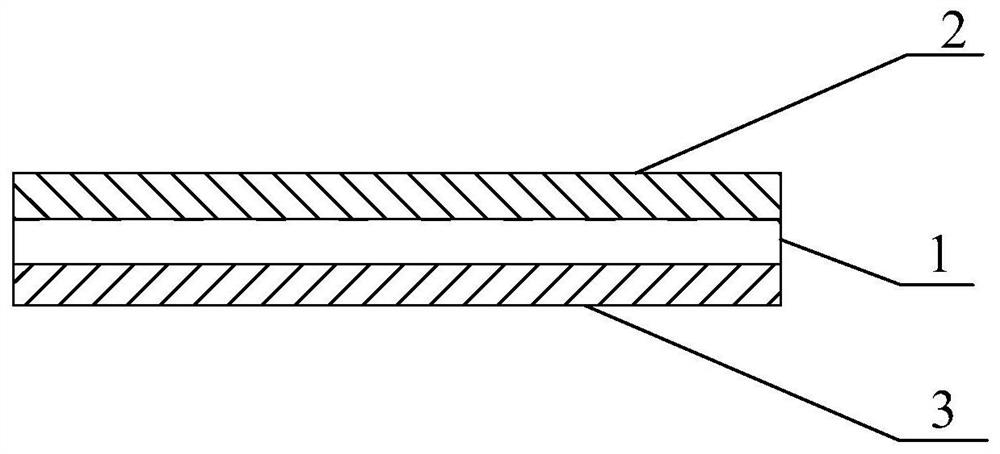Lithium ion battery Janus diaphragm
A lithium-ion battery and separator technology, applied in battery pack parts, circuits, electrical components, etc., can solve problems such as battery short circuit, inability to meet the specific needs of positive and negative plates, and achieve improved safety, improved safety and high temperature. Effects of Cycling Performance, High Capacity and Rate Capability
- Summary
- Abstract
- Description
- Claims
- Application Information
AI Technical Summary
Problems solved by technology
Method used
Image
Examples
Embodiment 1
[0029] Such as figure 1 As shown, a Janus separator for a lithium-ion battery is composed of a high-temperature-resistant support layer 1 and a polar functional layer 2 and a non-polar functional layer 3 supported on both sides of the high-temperature-resistant support layer. The polyimide prepared by electrospinning is used as the high-temperature-resistant support layer, the surface-grafted polyacrylic acid induced by ultraviolet rays is used as the polar functional layer, and the surface-coated polytetrafluoroethylene-hexafluoropropylene is used as the non-solvent-induced phase inversion method. The non-polar functional layer obtains the Janus diaphragm of lithium ion battery, and this Janus diaphragm thickness is 18 μ m, porosity 45.7%, thermal shrinkage rate 0.0% (150 ℃, 2h), the surface energy of polar functional layer is 45.8mN / m, non-polar The surface energy of the polar functional layer was 16.3 mN / m.
Embodiment 2
[0031] Such as figure 1 As shown, a Janus separator for a lithium-ion battery is composed of a high-temperature-resistant support layer 1 and a polar functional layer 2 and a non-polar functional layer 3 supported on both sides of the high-temperature-resistant support layer. Titanium oxide prepared by laser etching is used as a high-temperature resistant support layer, the surface is coated with polyethylene oxide as a polar functional layer, and the interface polymerized polyperfluoroethylene propylene is used as a non-polar functional layer to obtain a Janus separator for lithium-ion batteries , the thickness of the Janus separator is 5 μm, the porosity is 25%, the thermal shrinkage rate is 0.5% (150°C, 2h), the surface energy of the polar functional layer is 60.5mN / m, and the surface energy of the non-polar functional layer is 15.8mN / m m.
Embodiment 3
[0033] Such as figure 1As shown, a Janus separator for a lithium-ion battery is composed of a high-temperature-resistant support layer 1 and a polar functional layer 2 and a non-polar functional layer 3 supported on both sides of the high-temperature-resistant support layer. The polyether ether ketone prepared by melt-blown spinning is used as the high-temperature resistant support layer, the chemical vapor deposition 1:1 triethylenetetramine and polypropylene oxide is used as the polar functional layer, and the chemically grafted graphene is used as the non-polar layer. The functional layer obtains the Janus diaphragm of lithium ion battery, and the thickness of the Janus diaphragm is 50 μm, the porosity is 65%, the heat shrinkage rate is 0.2% (150°C, 2h), and the surface energy of the polar functional layer is 55.6mN / m, and the nonpolar The surface energy of the functional layer was 13.8 mN / m.
PUM
| Property | Measurement | Unit |
|---|---|---|
| thickness | aaaaa | aaaaa |
| thickness | aaaaa | aaaaa |
| thickness | aaaaa | aaaaa |
Abstract
Description
Claims
Application Information
 Login to View More
Login to View More - R&D Engineer
- R&D Manager
- IP Professional
- Industry Leading Data Capabilities
- Powerful AI technology
- Patent DNA Extraction
Browse by: Latest US Patents, China's latest patents, Technical Efficacy Thesaurus, Application Domain, Technology Topic, Popular Technical Reports.
© 2024 PatSnap. All rights reserved.Legal|Privacy policy|Modern Slavery Act Transparency Statement|Sitemap|About US| Contact US: help@patsnap.com









